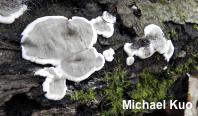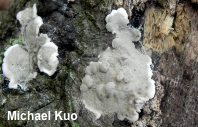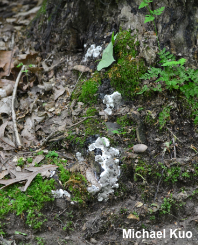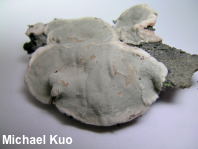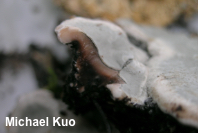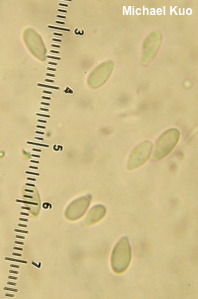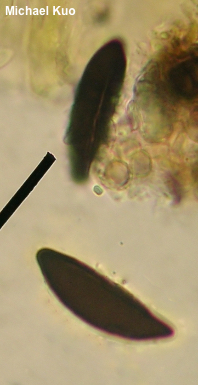| Major Groups > Crust Fungi > Kretzschmaria deusta |

|
Kretzschmaria deusta [ Ascomycota > Sordariomycetes > Xylariales > Xylariaceae > Kretzschmaria . . . ] by Michael Kuo In spring, in the Midwest and eastern North America, Kretzschmaria deusta forms gray patches on the wood of hardwoods, usually at the base of the tree, just above the ground. This stage of the fungus is often spied by mushroom hunters and naturalists, eager to be out in the woods after a long winter. By summer Kretzschmaria deusta turns into a hardened, black crust that is inconspicuous and usually overlooked by all but those who study such things. The spring version of Kretzschmaria deusta is asexual, producing conidia but not actual spores; it appears as a tough gray patch with a powdery surface and white edges. The later, sexual stage produces spores that look surprisingly like the spores of Xylaria species—and in fact Kretzschmaria and Xylaria are closely related. Description: Ecology: Saprobic on the living or dead wood of hardwoods; causing a white rot; often found at the bases of trees; spring through fall; common and widely distributed east of the Rocky Mountains. The illustrated and described collections are from Illinois. Springtime, Asexual Stage: Spreading in patches 2–9 cm across, irregular in outline; surface dull gray and dusty; dust rubbing off easily to expose a brownish, bumpy surface; white and smooth along the margin; 1–2 mm thick; flesh tough, watery whitish to brownish, developing embedded black dots; with a thin black line just under the upper surface. Summertime, Sexual Stage: Surface black, hard, bumpy, and lumpy, forming a crust over a cavity of whitish, powdery flesh that disintegrates to create a hollow structure. Odor: Not distinctive. Chemical Reactions: KOH on surface negative. Microscopic Features: Conidia 4–7.5 x 2–3 µm; subfusiform to elongated-lacrymoid; smooth; hyaline in KOH; produced on cylindric elements 25–45 x 2–4 µm. Spores 30–32 x 8–9 µm; fusiform; with a pale, longitudinal germ slit that does not extend to the ends of the spore; smooth; very dark brown to black in KOH. REFERENCES: (G. F. Hoffman, 1787) P. M. D. Martin, 1970. (Bulliard, 1791; Gray, 1821; Breitenbach & Kränzlin, 1984; Phillips, 1991/2005; Lincoff, 1992; Rogers & Ju, 1998; McNeil, 2006; Rogers et al., 2008; Beug et al., 2014; Woehrel & Light, 2017; Elliott & Stephenson, 2018.) Herb. Kuo 05060607, 05111101, 05181802. This site contains no information about the edibility or toxicity of mushrooms. |
<
© MushroomExpert.Com |
|
Cite this page as: Kuo, M. (2018, July). Kretzschmaria deusta. Retrieved from the MushroomExpert.Com Web site: http://www.mushroomexpert.com/kretzschmaria_deusta.html |
